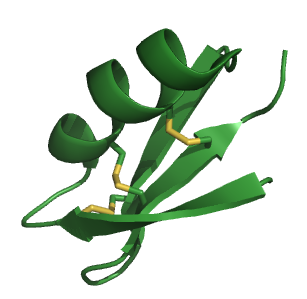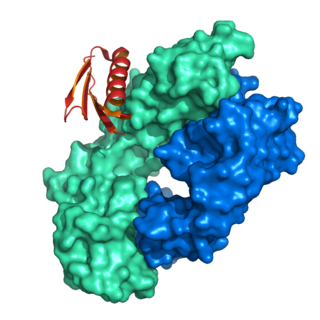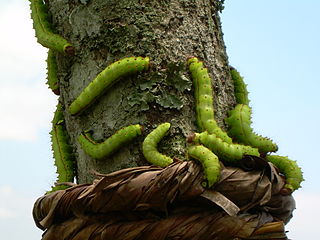
Biopolymers are natural polymers produced by the cells of living organisms. Like other polymers, biopolymers consist of monomeric units that are covalently bonded in chains to form larger molecules. There are three main classes of biopolymers, classified according to the monomers used and the structure of the biopolymer formed: polynucleotides, polypeptides, and polysaccharides. The Polynucleotides, RNA and DNA, are long polymers of nucleotides. Polypeptides include proteins and shorter polymers of amino acids; some major examples include collagen, actin, and fibrin. Polysaccharides are linear or branched chains of sugar carbohydrates; examples include starch, cellulose, and alginate. Other examples of biopolymers include natural rubbers, suberin and lignin, cutin and cutan, melanin, and polyhydroxyalkanoates (PHAs).

Keratin is one of a family of structural fibrous proteins also known as scleroproteins. Alpha-keratin (α-keratin) is a type of keratin found in vertebrates. It is the key structural material making up scales, hair, nails, feathers, horns, claws, hooves, and the outer layer of skin among vertebrates. Keratin also protects epithelial cells from damage or stress. Keratin is extremely insoluble in water and organic solvents. Keratin monomers assemble into bundles to form intermediate filaments, which are tough and form strong unmineralized epidermal appendages found in reptiles, birds, amphibians, and mammals. Excessive keratinization participate in fortification of certain tissues such as in horns of cattle and rhinos, and armadillos' osteoderm. The only other biological matter known to approximate the toughness of keratinized tissue is chitin. Keratin comes in two types, the primitive, softer forms found in all vertebrates and harder, derived forms found only among sauropsids.

Silk is a natural protein fiber, some forms of which can be woven into textiles. The protein fiber of silk is composed mainly of fibroin and is produced by certain insect larvae to form cocoons. The best-known silk is obtained from the cocoons of the larvae of the mulberry silkworm Bombyx mori reared in captivity (sericulture). The shimmering appearance of silk is due to the triangular prism-like structure of the silk fibre, which allows silk cloth to refract incoming light at different angles, thus producing different colors.

Bombyx mori, commonly known as the domestic silk moth, is a moth species belonging to the family Bombycidae. It is the closest relative of Bombyx mandarina, the wild silk moth. Silkworm are the larvae of silk moths. The silkworm is of particular economic value, being a primary producer of silk. The silkworm's preferred food are the leaves of white mulberry, though they may eat other species of mulberry, and even leaves of other plants like the osage orange. Domestic silk moths are entirely dependent on humans for reproduction, as a result of millennia of selective breeding. Wild silk moths, which are other species of Bombyx, are not as commercially viable in the production of silk.

Spider silk is a protein fibre or silk spun by spiders. Spiders use silk to make webs or other structures that function as adhesive traps to catch prey, to entangle and restrain prey before biting, to transmit tactile information, or as nests or cocoons to protect their offspring. They can use the silk to suspend themselves from height, to float through the air, or to glide away from predators. Most spiders vary the thickness and adhesiveness of their silk according to its use.

Heme, or haem, is a ring-shaped iron-containing molecular component of hemoglobin, which is necessary to bind oxygen in the bloodstream. It is composed of four pyrrole rings with 2 vinyl and 2 propionic acid side chains. Heme is biosynthesized in both the bone marrow and the liver.

In biology and biochemistry, the active site is the region of an enzyme where substrate molecules bind and undergo a chemical reaction. The active site consists of amino acid residues that form temporary bonds with the substrate, the binding site, and residues that catalyse a reaction of that substrate, the catalytic site. Although the active site occupies only ~10–20% of the volume of an enzyme, it is the most important part as it directly catalyzes the chemical reaction. It usually consists of three to four amino acids, while other amino acids within the protein are required to maintain the tertiary structure of the enzymes.
Gonadotropins are glycoprotein hormones secreted by gonadotropic cells of the anterior pituitary of vertebrates. This family includes the mammalian hormones follicle-stimulating hormone (FSH) and luteinizing hormone (LH), the placental/chorionic gonadotropins, human chorionic gonadotropin (hCG) and equine chorionic gonadotropin (eCG), as well as at least two forms of fish gonadotropins. These hormones are central to the complex endocrine system that regulates normal growth, sexual development, and reproductive function. LH and FSH are secreted by the anterior pituitary gland, while hCG and eCG are secreted by the placenta in pregnant humans and mares, respectively. The gonadotropins act on the gonads, controlling gamete and sex hormone production.

Agitoxin is a toxin found in the venom of the scorpion Leiurus quinquestriatus hebraeus. Other toxins found in this species include charybdotoxin (CTX). CTX is a close homologue of Agitoxin.

Protein L was first isolated from the surface of bacterial species Peptostreptococcus magnus and was found to bind immunoglobulins through L chain interaction, from which the name was suggested. It consists of 719 amino acid residues. The molecular weight of protein L purified from the cell walls of Peptostreptoccus magnus was first estimated as 95kD by SDS-PAGE in the presence of reducing agent 2-mercaptoethanol, while the molecular weight was determined to 76kD by gel chromatography in the presence of 6 M guanidine HCl. Protein L does not contain any interchain disulfide loops, nor does it consist of disulfide-linked subunits. It is an acidic molecule with a pI of 4.0. Unlike protein A and protein G, which bind to the Fc region of immunoglobulins (antibodies), protein L binds antibodies through light chain interactions. Since no part of the heavy chain is involved in the binding interaction, Protein L binds a wider range of antibody classes than protein A or G. Protein L binds to representatives of all antibody classes, including IgG, IgM, IgA, IgE and IgD. Single chain variable fragments (scFv) and Fab fragments also bind to protein L.
A nerve guidance conduit is an artificial means of guiding axonal regrowth to facilitate nerve regeneration and is one of several clinical treatments for nerve injuries. When direct suturing of the two stumps of a severed nerve cannot be accomplished without tension, the standard clinical treatment for peripheral nerve injuries is autologous nerve grafting. Due to the limited availability of donor tissue and functional recovery in autologous nerve grafting, neural tissue engineering research has focused on the development of bioartificial nerve guidance conduits as an alternative treatment, especially for large defects. Similar techniques are also being explored for nerve repair in the spinal cord but nerve regeneration in the central nervous system poses a greater challenge because its axons do not regenerate appreciably in their native environment.

Wild silks have been known and used in many countries from early times, although the scale of production is far smaller than that from cultivated silkworms. Silk cocoons and nests often resemble paper or cloth, and their use has arisen independently in many societies.
Sericin is a protein created by Bombyx mori (silkworms) in the production of silk. Silk is a fibre produced by the silkworm in production of its cocoon. It consists mainly of two proteins, fibroin and sericin. Silk consists of 70–80% fibroin and 20–30% sericin; fibroin being the structural center of the silk, and sericin being the gum coating the fibres and allowing them to stick to each other.
Haem peroxidases (or heme peroxidases) are haem-containing enzymes that use hydrogen peroxide as the electron acceptor to catalyse a number of oxidative reactions. Most haem peroxidases follow the reaction scheme:
Demineralizing has the potential to be used in the silk sector enabling wet reeling of Wild Silk moth cocoons by removing the mineral layer present in these cocoons. This technique is not like degumming where the gum of the fibroin fibres is removed what would lead to a tangled cocoon. With "demineralizing" the gum and structure of the cocoon is kept intact enabling the cocoons to be wet reeled. This could allow a new silk industry in areas which have not the conditions or infrastructure for raising the domesticated silk worm Bombyx mori, possibly generating a revolutionary new income stream.
Silk amino acid (SAAs) also known as Sericin is a natural water-soluble glycoprotein extracted from raw silk. It is used as an additive in skin and hair care products due to its high levels of serine which has excellent moisture preservation characteristics. As a water-based additive it is used to provide a protective barrier and silky feel to lotions, soaps, personal lubricants, hair and skincare products. Silk amino acids are produced by hydrolyzing silk proteins into smaller peptide chains, typically 18 to 19 amino acids in length. Silk amino acids have a lower molecular weight than silk protein powders and are moisturizing to skin and hair.
An aquamelt is a naturally hydrated polymeric material that is able to solidify at environmental temperatures through a controlled stress input.

In molecular biology, protein fold classes are broad categories of protein tertiary structure topology. They describe groups of proteins that share similar amino acid and secondary structure proportions. Each class contains multiple, independent protein superfamilies.
Caddisfly silk is silk that is secreted by the silk glands of the caddisfly (Trichoptera), similar to Lepidoptera silkworms. The larvae use silk to hunt and defend themselves. The silk's underwater binding properties are a subject of ongoing scientific research.
Tamulotoxin is a venomous neurotoxin from the Indian Red Scorpion.











